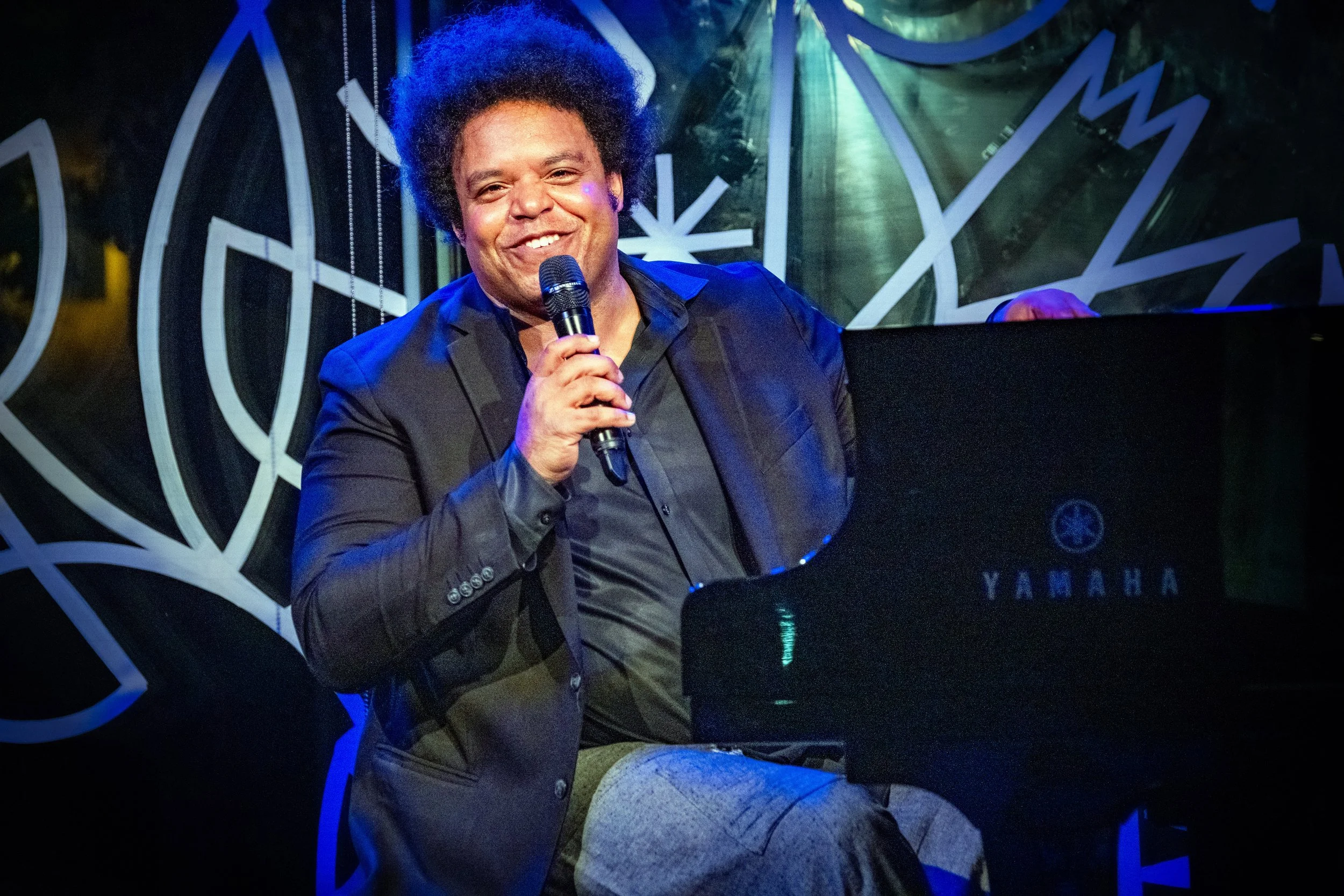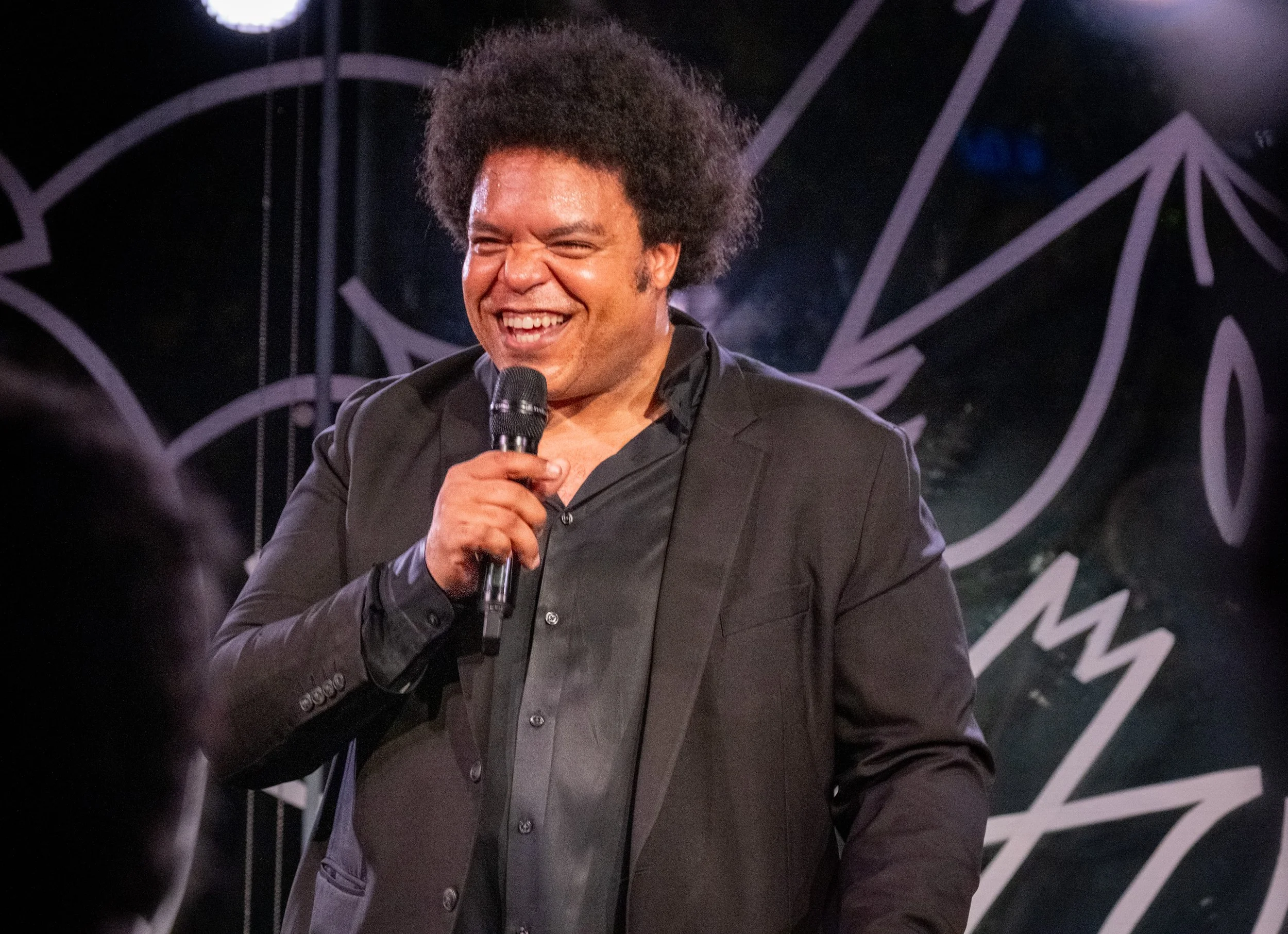Through the Wormhole: ELEW Gives Sting New Gravity
ELEW
Rock Meets Jazz: ELEW PLAYS STING (first set)
Joe Henderson Lab
San Francisco, California
September 13, 2025
ELEW. Photo: Steve Roby
“Sting is such a lyrical genius. Some of these tunes have Evergreen principles and how they apply to life and current-day situations.”
The evening clicked into focus the instant ELEW raised his hands above the keyboard and did nothing. Not a feint; a recalibration. The room quieted to his breathing, and when the first left‑hand pattern of “Message in a Bottle” finally arrived, it sounded more like scaffolding than melody—a bass figure laid down as a flexible floor, rubberized and springy, for the right hand to test in careful steps. He teased cross‑rhythms until the groove wobbled like a pier hit by crosscurrents, then snapped it back into alignment so cleanly that the correction read as part of the design. Showmanship rode on the surface—the grin, the head toss—but underneath was a drafter’s precision: trills used like scratches, pedaled resonance as a cross‑fade. He wasn’t mimicking the record; he was reverse‑engineering it into a machine for tension and release.
Later, he explained his charged silences before each piece. Sting’s songs, he said, require a complete reset: “Sting’s music is so specific and distinct that I must adjust my whole brand of playing for each song. That’s why I must stop and really clear the palette of what I just did. For me, it’s like, ‘Okay, where am I at? What planet am I going to?’ Because each of Sting’s tunes is like going to another planet for me. And it’s like, I gotta go through a completely different wormhole to get there.”
The most drastic climate shift came with “Fragile.” He cleared space, let the overtones bloom in the lower register, and placed spare, heavy chords under a melody that leaned out over lengthy suspensions—seconds and ninths that refused to hurry. Midway through, the right hand trembled against the left, and the crescendo wasn’t a Romantic swell so much as a pressure build, as if the room itself had been sealed. He ended on an open sonority and held still, letting the silence harden before applause.
ELEW. Photo: Steve Roby
ELEW’s stage body reads like an annotated score. He consults the ceiling, resets his shoulders, and murmurs counts. He even introduces “my other band,” the left hand that covers bass and rhythm with the endurance of an athlete. In a room as close as the Joe Henderson Lab, short attacks, long tones translate his inner click track into something the audience can read. The music gained a documentary layer: you could watch him negotiate touch, weight, and speed in real time.
“Don’t Stand So Close to Me” became a study in registers and distance. He reached into the piano and flicked muted strings—an intimate guitar whisper—then answered with low, hammered fourths that landed like a school bell on the desk in front of you. Proximity turned into harmony: delicate figures placed far away against blunt ones right on top of you. He kept the texture thin, the stakes oddly high, as if a step too heavy would tip the balance. Every ounce of touch seemed weighed before it landed.
The night’s most radical transformation arrived with “Every Breath You Take.” Instead of bathing the arpeggios in melancholy, he burrowed into a left‑hand boogie and steered the right hand toward barrelhouse turns, blues‑church smears, and a bright two‑beat saunter that nodded to New Orleans parade rhythms. The familiar melody learned to party, and the groove didn’t cancel the song’s unease; it disguised it, which may be closer to how surveillance behaves in daily life—present, smiling, everywhere. That little cultural argument—the idea that rhythm can hide a knife—gave the set its snap.
“While I was on tour with Sting… it was so inspiring that I decided to make an album called ELEW Plays Sting.”
What prevents this project from becoming mere repertoire is a fresh reflection beneath its exuberance. His extensive practice of blending rock rhetoric with jazz articulation (and vice versa) allows him to shift weight and tone without creating clutter. He obsessively examines what role each hand plays in the imagined band: bass amp or rhythm guitar pedalboard, snare drum or cymbal splash. In “Englishman in New York,” he discovered a syncopated walk for the left hand—half stride, half city grid—while the right hand added clipped notes that flirted with charm. Civility met friction; a cosmopolitan waltz shaded into crosswalk metal.
Context mattered to the evening’s subtext. ELEW has been opening for Sting and developing a whole album of these treatments. He said as much from the stage, and the first set was recorded. The Lab suited the premise. These weren’t museum archives; they were working shapes being exposed to torque, speed, and heat. A texture buckled once or twice—a restart on “Murder by Numbers,” a recalibrated tempo elsewhere—but most of the time the material flexed and held, clarified by pressure. You didn’t miss a rhythm section because he understands how to cook heat out of a single instrument: pedaled haze as reverb, crisp staccato for snare articulation, wide open chords spread across a big range of the keyboard.
ELEW. Photo: Steve Roby
He knows the room, too. The Lab magnifies overtones and reveals seams. He compensated by tightening transitions, pinning accents at the front of the note, and using silences like commas you could feel in your ribs. Audience energy—guesses, yelps, laughter—became offstage percussion. By the time he closed with that boogie-tinged “Every Breath,” eyes lit up, shoulders rolling, the place had shifted from a recital hall to a workshop. After the last chord, a fast, grateful ovation lifted him from the bench and pushed him into a huddle of phone photos and thanks.
Here is one way to understand the night: the repertoire supplied the words; touch, pressure, and register wrote the subtext. A left hand can turn affirmation into suspicion, or suspicion into celebration. A held suspension can make a familiar melody step forward like a person, not a theme. And an audience’s delay before applause can demonstrate astonishment.
If a song’s character can be changed so completely by weight, space, and surface—if menace can dance and the cadence is teased, then withheld—where does the song truly reside? In the chord changes, the memory of a voice, the hand that strikes the key, or the audience’s breath in a small glass-walled room? On this night, the answer kept shifting and chasing it felt like the point.
Setlist: “Message In A Bottle,” “Murder By Numbers,” “Walking On The Moon,” “King Of Pain,” “Fragile,” “Englishman In New York,” “Don’t Stand So Close To Me,” “Every Breath You Take.”
Listen to our podcast interview with ELEW here.


